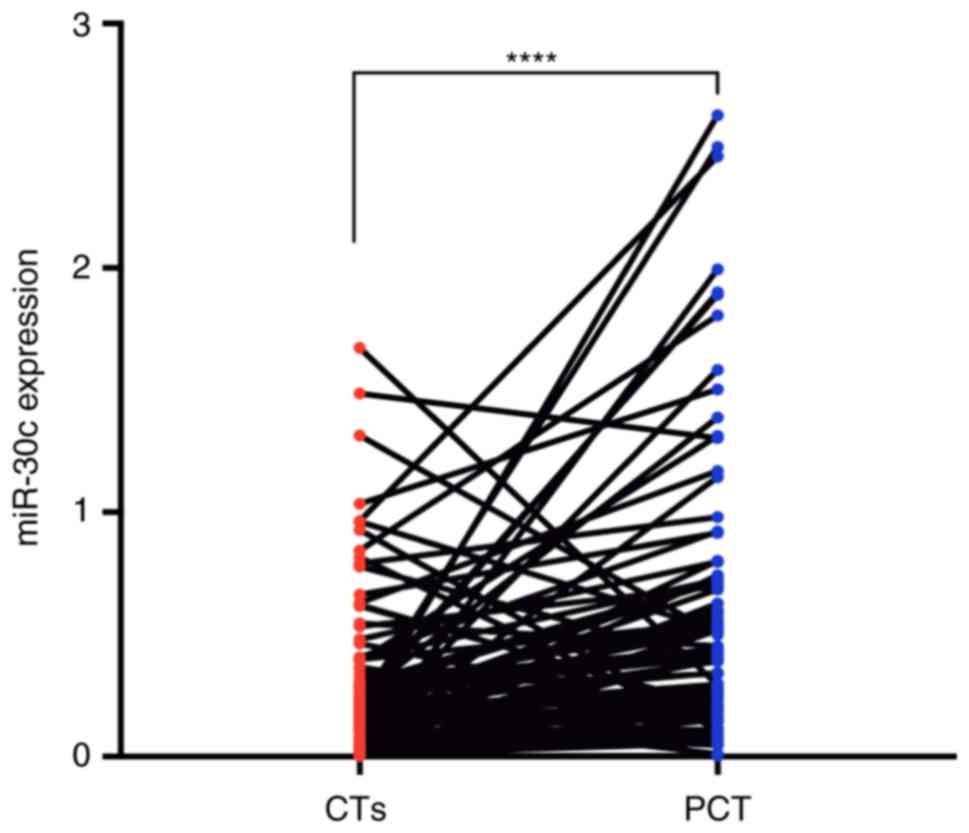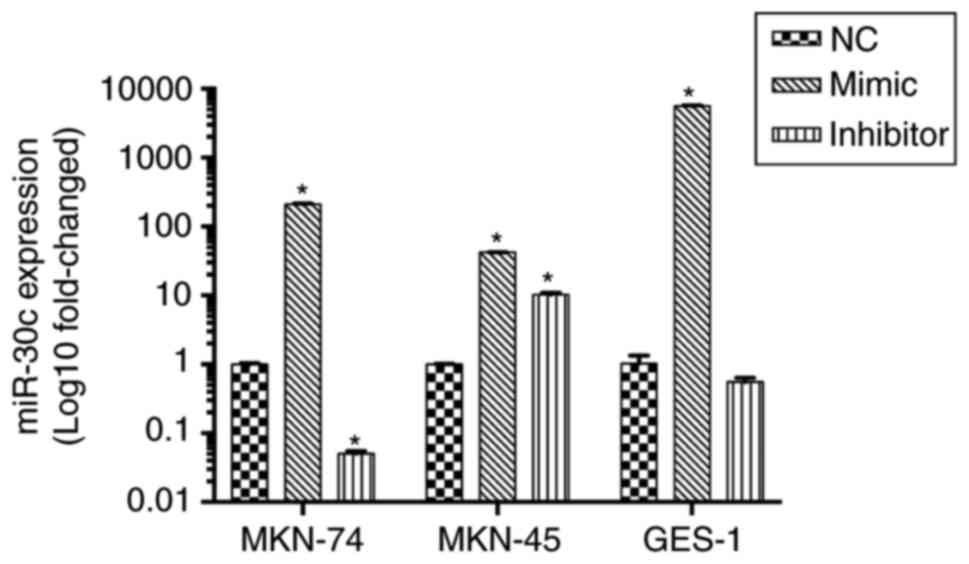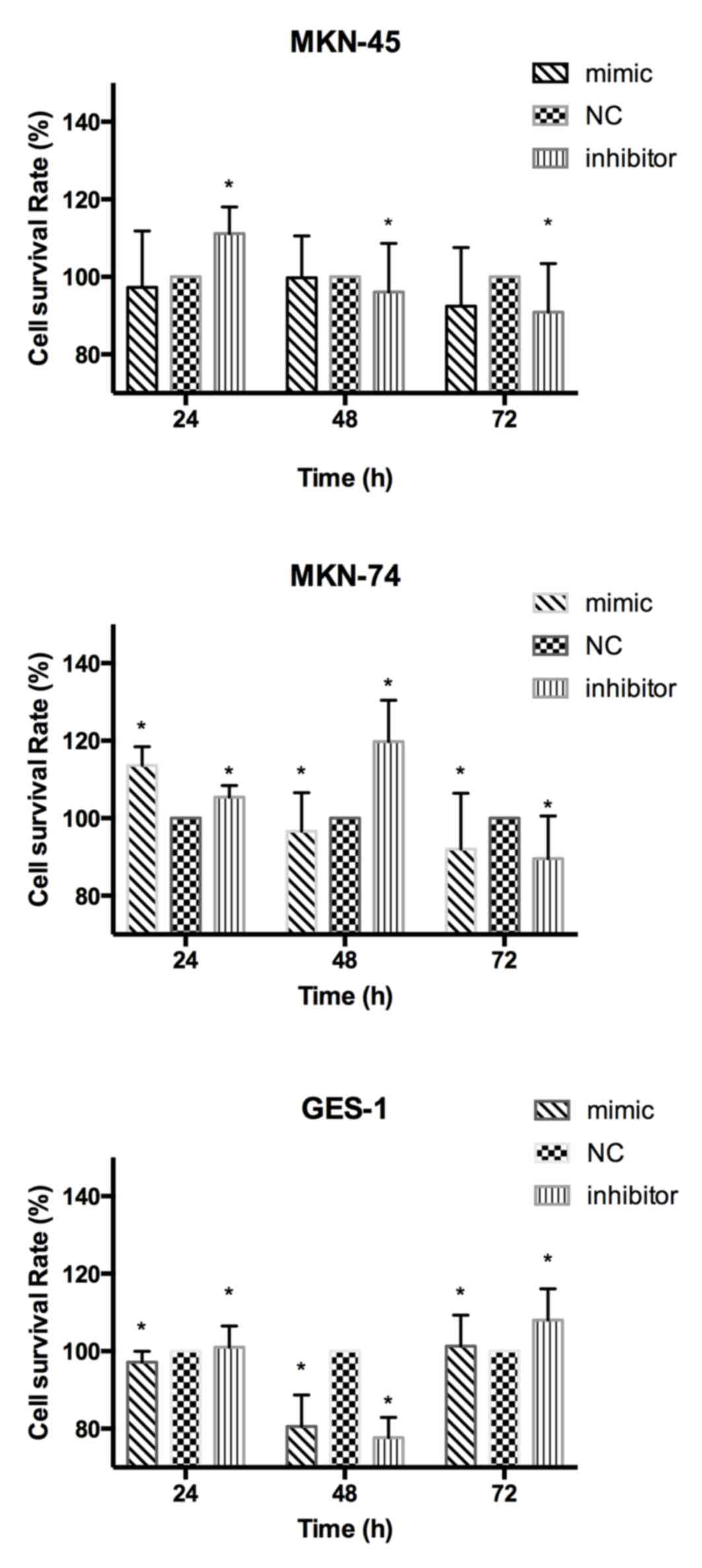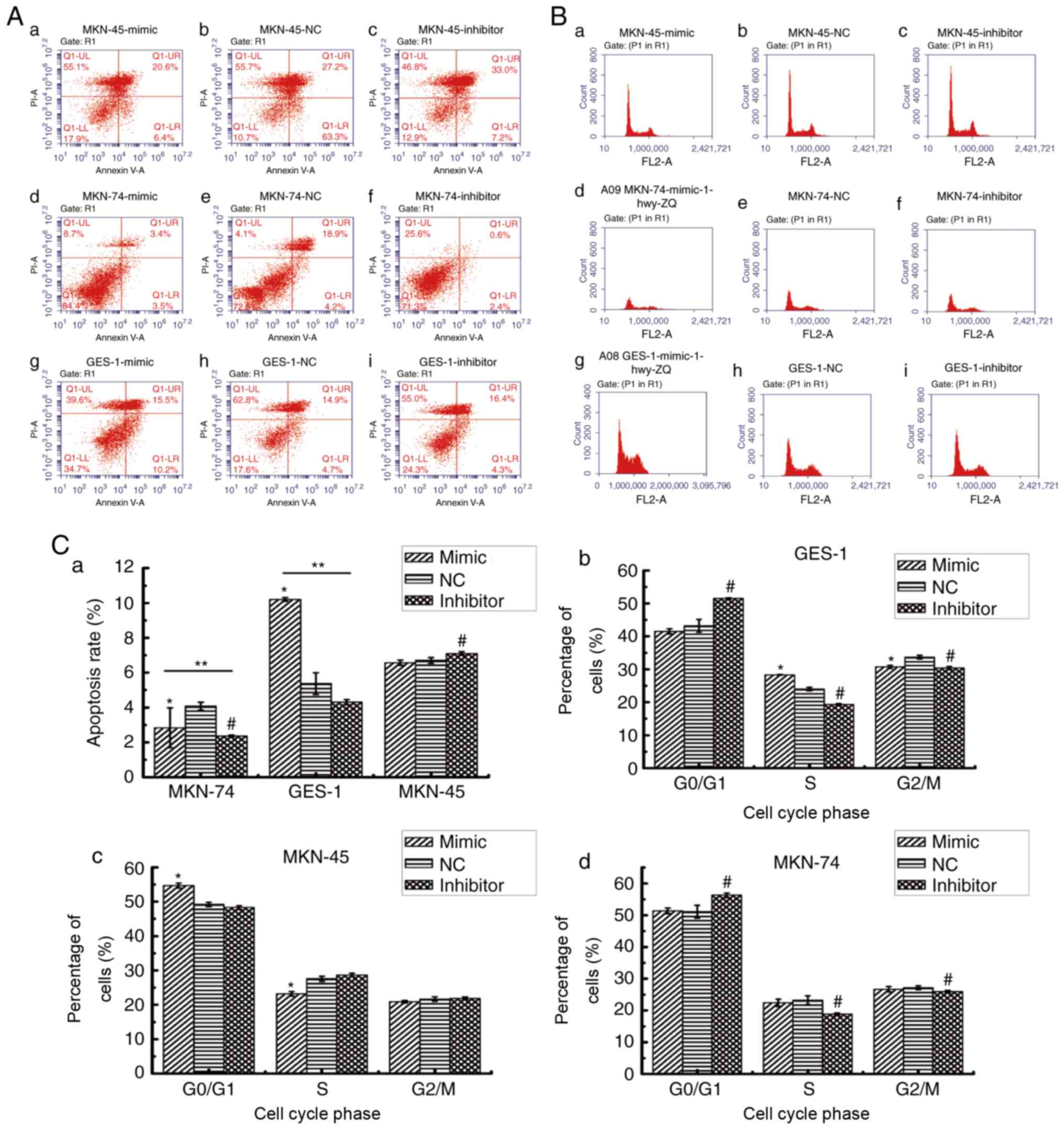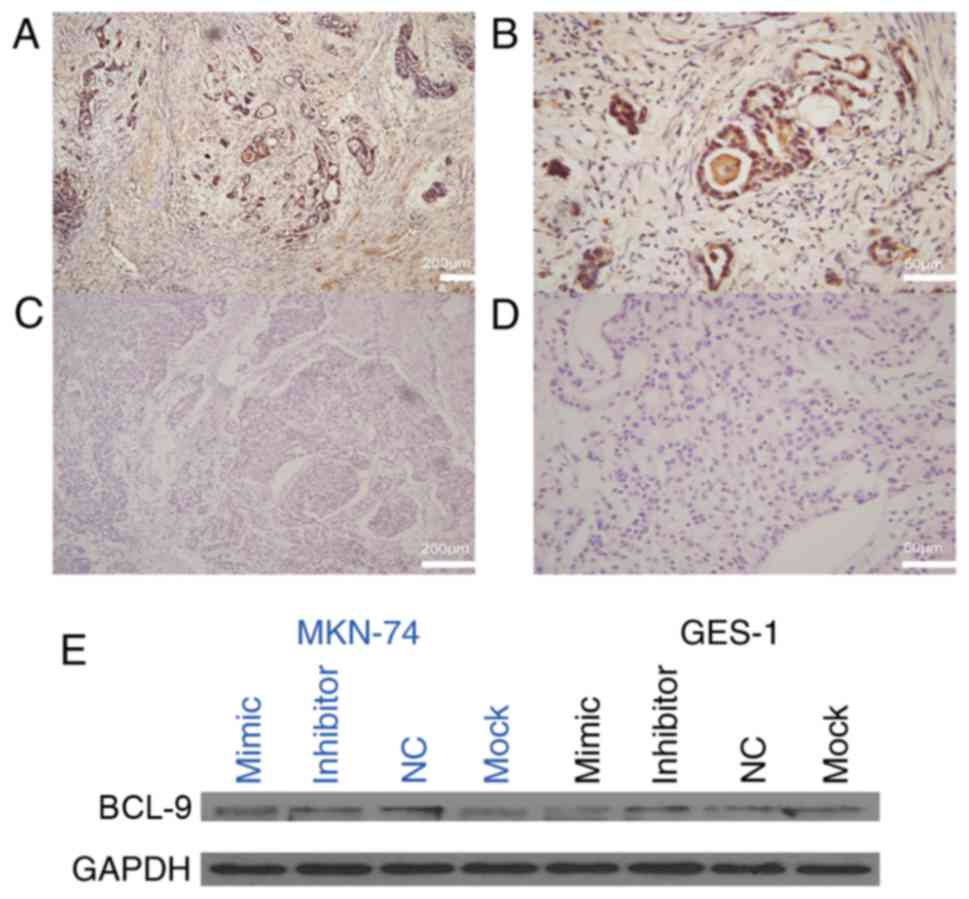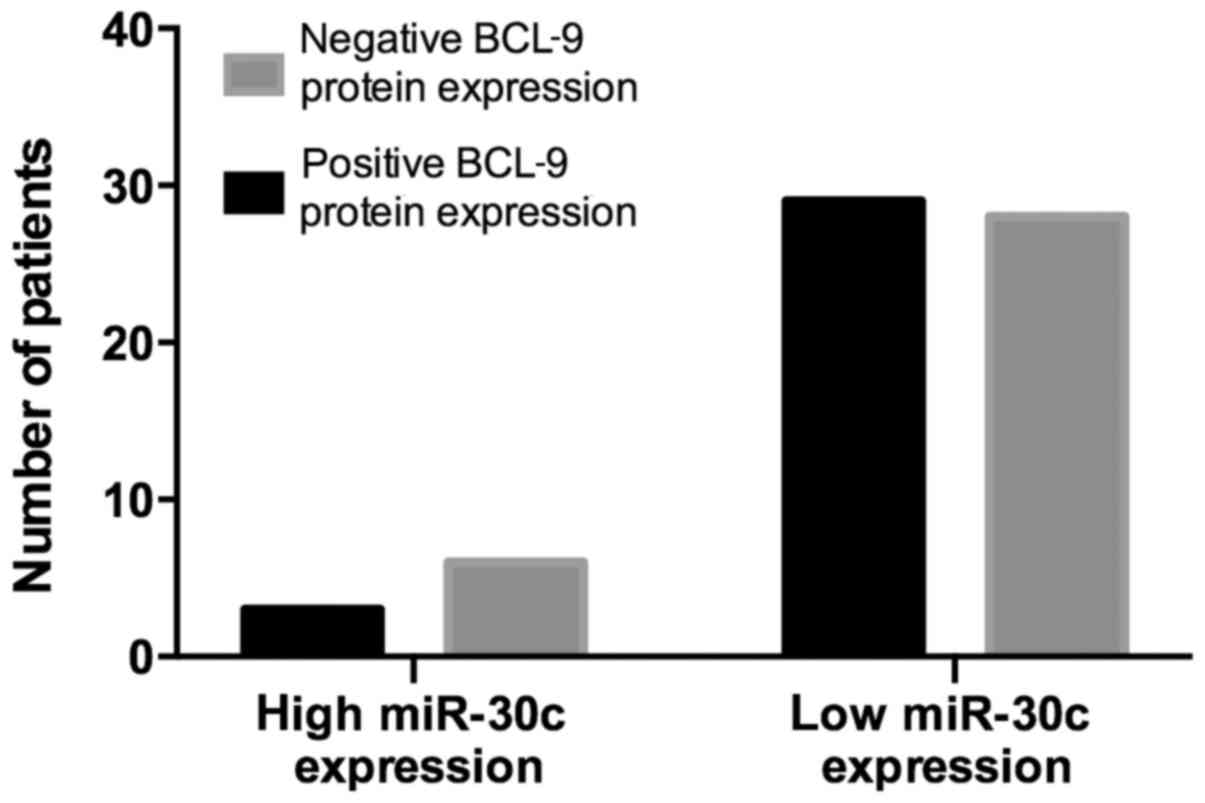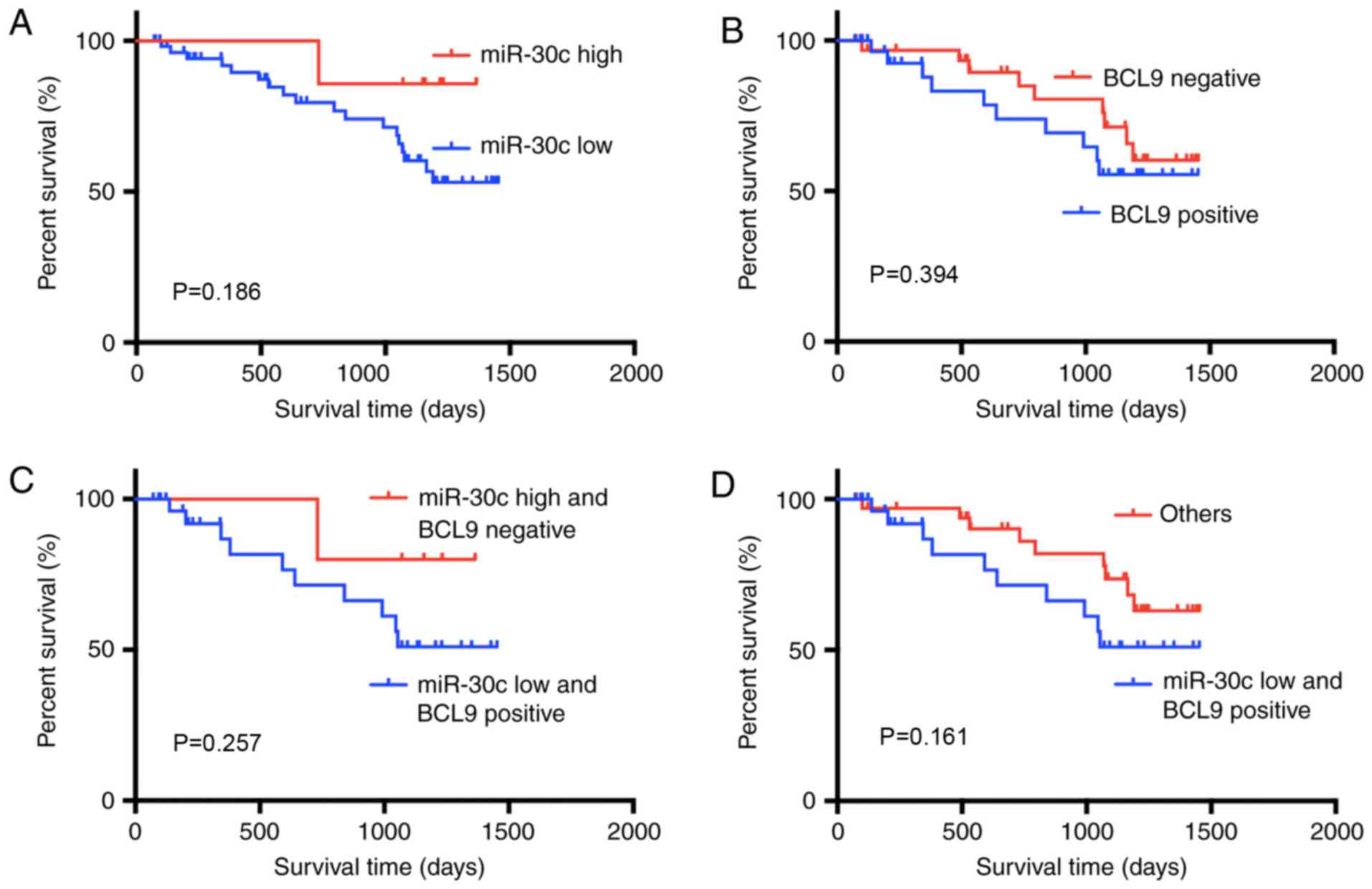Introduction
Gastric cancer (GC) is a common malignancy of the
gastrointestinal tract, and it is the second most frequent cause of
cancer mortality globally (1,2). According to global statistics,
>8,000,000 novel cases of GC are diagnosed annually, and GC
mortalities account for 9% of the total number of cancer-associated
mortalities worldwide (3). The
etiology of the disease is complicated, and the pathogenesis of GC
remains unclear. microRNAs (miRNAs) are a class of endogenous,
non-coding, single stranded small RNAs, consisting of ~20–24
nucleotides that serve key roles in the regulation of gene
expression (4). In the context of GC,
the actions of specific miRNAs influence cell proliferation and
differentiation, apoptosis, signal transduction, inflammation and
tumor progression (5–13). miR-30c is a member of the miR-30s
family, which is known to serve an important role in the occurrence
and development of numerous tumor types, including breast cancer,
endometrial cancer, lung cancer, colon cancer and liver cancer
(14–18). It is considered to be a tumor
suppressor miRNA, with a role in inhibiting cancer cell
proliferation, invasion and migration (14,18). It
can also be used to predict the efficacy and prognosis of drugs for
the treatment of cancer (19–21). In a preliminary study, the expression
of 1,146 miRNAs in GC and distal tissues was investigated using
miRNA microarray technology (22).
The differential expression of miR-30c in 82 paired GC and
paracancerous tissues was detected and the probable mechanisms of
action and the potential clinical applications of miR-30c-based
interventions were discussed.
Materials and methods
Human GC tissue samples
A total of 82 human GC and paired distal
paracancerous tissue samples were obtained from patients who
underwent GC surgery at the Affiliated Hospital of Inner Mongolia
Medical University (Hohhot, China) between May 2012 and May 2013.
Paracancerous tissue samples were defined as precancerous tissue
samples cut <3 cm from the cancer tissues (CTs) and derived from
non-cancerous tissue, but different from normal tissue. The
patients enrolled in the present study did not receive any
radiation or chemotherapy prior to surgery. The present study
received ethical approval from The Affiliated Hospital of Inner
Mongolia Medical University's ethics committee. All patients
provided written informed consent and had received a confirmed
diagnosis from a senior pathologist. A total of 62 male cases and
20 female cases aged between 31 and 77 years (average age,
60.27±9.72 years) comprised the study sample. A total of five
additional paired GC and adjacent tissue samples were obtained and
used for GC miRNA microarray research [4 male cases and 1 female
case, aged 43–70 years (average age, 57.2±10.6 years old) (22). The tissue samples were obtained during
surgery, immediately washed in saline and cut into 0.3
cm2 blocks prior to being loaded into labelled tubes and
rapidly frozen in liquid nitrogen, to prevent the degradation of
RNA. The Tumor-Node-Metastasis staging system used was the 2013
National Cancer Institute Cancer staging system (23).
Microarray analysis
Total RNA was extracted from the tissue samples
using the mirVana RNA Isolation kit (Ambion; Thermo Fisher
Scientific, Inc., Waltham, MA, USA) for miRNA gene microarray
analysis (LuxScan image analysis system; version 3.0; Beijing Skoll
Biotechnology Co., Beijing, China). The miRNA gene expression
microarray analysis was performed using a type Human V2 MicroRNA
Expression chip Profiling kit linked with a BeadChip scanning
instrument (Illumina, Inc., San Diego, CA, USA). BeadChip Images
were processed and analyzed using the iScan System for the
BeadArray Reader Illumina (Illumina, Inc.) as described in a
previous study (22).
Culture of cell lines
A total of three cell lines were obtained from the
Clinical Research Center of The Affiliated Hospital of Inner
Mongolia Medical University, including: Poorly differentiated GC
cell line MKN-45; highly differentiated cells MKN-74; and
immortalized, non-tumorigenic human gastric epithelial cell line
GES-1 (24–26). These three cell lines were cultured in
RPMI-1640 supplemented with 10% fetal bovine serum, 100 µg/ml
streptomycin and 100 U/ml penicillin (all obtained from Gibco;
Thermo Fisher Scientific, Inc.). Cultures were maintained at 37°C
in an atmosphere containing 5% CO2.
Cell transfection using
Lipofectamine® 2000
A total of four experimental groups were defined: A
mimic miR-30c group; a transfected negative control (NC) group; a
transfected inhibitor miR-30c group; and MOCK group
(non-transfected cell). To alter the expression of miR-30c in
vivo, 1×105 MKN-45, MKN-74 and GES-1 cells were
plated in 96-well plates following culturing with Opti-MEM I
reduced-serum medium (Gibco; Thermo Fisher Scientific, Inc.) for 12
h, at 37°C in an atmosphere containing 5% CO2, according
to the manufacturer's protocols. Lipofectamine 2000 Transfection
Reagent (Invitrogen; Thermo Fisher Scientific, Inc.) was added,
along with 50 nM miR-30c mimic (3′-ACAUUUGUAGGAUGUGAGAGUCG-5′), 50
nM miRNA NC (3′-AAACAUGAUGUGUUUUCAUGAC-5′) or 100 nM
miR-30c-inhibitor (5′-GCUGAGAGUGUAGGAUGUUUACA-3′) (all from RiboBio
Co., Ltd., Guangzhou, China). Following transfection for 48 h,
cells were collected.
MTT assay to assess cell
viability
A 20 µl aliquot of MTT solution (5 mg/ml) was added
to each well of the 96-well plates containing the cultured
transfected cells, and the plates were incubated for 4 h, at 37°C
in an atmosphere containing 5% CO2, The supernatant from
each well was then carefully extracted, and 150 µl dimethyl
sulfoxide was added to each well prior to shaking for 10 min to
dissolve the formazan crystals. The absorbance value (optical
density value) of each well was then measured at a wavelength of
570 nm.
Cell separation by flow cytometry
Single cell suspensions were prepared from the
tissue samples by centrifugation for 5 min at 168 × g at room
temperature, followed by removal of the supernatant and washing
with Dulbecco's PBS (DPBS, Gibco; Thermo Fisher Scientific, Inc.)
twice prior to the collection of 5×105 cells. A 5 µl
aliquot of Annexin V-FITC (Annexin V-FITC Apoptosis Detection Kit,
gtx85591; GeneTex, Inc., Irvine, CA, USA) was then added along with
20 µl propidium iodide. The solution was mixed and allowed to react
at room temperature in the dark for 15 min prior to being subjected
to analysis using with a flow cytometer using Flow Cytometry
Modeling software 4.0 (BD Accuri C6; BD Biosciences, Franklin
Lakes, NJ, USA) in order to observe and analyze the changes in cell
apoptosis and the cell cycle.
Total RNA extraction and
identification of RNA concentration and purity
Total RNA was extracted with TRIzol®
(Life Technologies; Thermo Fisher Scientific, Inc.), Ethanol
absolute, Isopropyl alcohol, Chloroform (Tianjin Beilian fine
Chemicals Development Co., Ltd., Tianjin, China) in accordance with
the manufacturer's protocol for the extraction of tissues and
cells. RNase-free ddH2O (Tiangen Biotech Co., Ltd.,
Beijing, China) was used to dilute the extracted RNA to 60 µl, and
a 2 µl sample of the dissolved RNA was added to the NanoDrop 2000c
spectrophotometer (Thermo Fisher Scientific, Inc.) to assess the
quality of the RNA. Detection of RNA was performed using the ratio
of absorbance at the 260 and 280 nm wavelengths. A ratio of 1.8–2.0
RNA indicated high purity. A total of 4 µl RNA was prepared for
electrophoresis in a 2% agarose gel, with the voltage set at 120 V
for 25 min. Data were analyzed using Bio-Capt software 10.0 (Bio
Capt Express, Vilber Lourmat, France).
cDNA synthesis and reverse
transcription-quantitative polymerase chain reaction (RT-qPCR)
First-strand cDNA was synthesized in accordance with
the protocols of the miRcute miRNA cDNA First-Strand Synthesis Kit
(KR201, Tiangen Biotech Co., Ltd., Beijing, China). Using hsa-U6
(CD201-0145; Tiangen Biotech Co., Ltd.) as a reference gene,
hsa-miR-30c-5p (CD201-0338; Tiangen Biotech Co., Ltd.) was
amplified, and the amplification products were detected via RT-qPCR
using an Applied Biosystems 7500 Real-time PCR System (Applied
Biosystems; Thermo Fisher Scientific, Inc.). This produced a cDNA
amplification curve in which the dissolution curves exhibited no
impurity peaks, indicating non-specific amplification. Following an
initial template deformation step at 94°C for 2 min, template
degeneration was achieved at 94°C for 20 sec, followed by annealing
and elongation at 60°C for 34 sec. This was repeated for a total of
40 cycles. Experiments were carried out in triplicate wells and
were repeated three times. The relative expression was measured
using the 2−ΔΔCq method (27).
Immunohistochemistry
The GC tissue samples were fixed with 4%
Paraformaldehyde Fix Solution (P0099; Beyotime Institute of
Biotechnology, Haimen, China) for 24 h at room temperature, were
embedded in paraffin, sliced into 4 µm thick sections and subjected
to immunohistochemistry. PBS was used as a NC, and BCL-9 positive
GC tissue sections were used as a positive control. BCL-9 protein
(cat no. ab37305; Abcam, Cambridge, UK) expression was detected
immunohistochemically using a 1:1,000 DPBS dilution followed by
incubation overnight at 4°C. Samples were then washed in PBS 3
times, followed by incubation with goat anti-mouse, rabbit IgG
polymer (MaxVision™ kit; Fuzhou Maixin Biotech Co., Ltd., Fuzhou,
China) and DAB stain (Fuzhou Maixin Biotech Co., Ltd.) in
accordance with the manufacturer's protocols. BCL-9 positive
expression was visible as yellow or brown particles, and was
predominantly located in the nucleus, with limited expression in
the cytoplasm. The results were observed with a light microscope
(magnification, ×40, ×100, ×400), CellSens Standard 1.11 software
(CX41; Olympus Corporation, Tokyo, Japan) used for image capture
and classified by an expert clinical pathologist (from the
Affiliated Hospital of Inner Mongolia Medical University, Hohhot,
China) according to the following: The score of staining degree
(Point1) × the percentage of stained cells (Point2). A final score
of 0~3 was designated as negative expression, >4 as positive
expression. The rating criteria are defined in Table I.
 | Table I.Core criteria for immunohistochemical
classification of B-cell lymphoma 9 positivity of analyzed tissue
samples. |
Table I.
Core criteria for immunohistochemical
classification of B-cell lymphoma 9 positivity of analyzed tissue
samples.
| Staining
degree | Point1 | Percentage of
stained cells | Point2 | Point1*Point2 | Assigned
rating |
|---|
|
Basic-non-coloring | 0 | <5% | 0 | 0–1 | (−) |
| Canary-yellow | 1 | 5–25% | 1 | 2–3 | (+) |
| Pale-brown | 2 | 26–50% | 2 | 4–6 | (++) |
| Tan | 3 | >50% | 3 | >6 | (+++) |
Western blot analysis
The MKN-74, GES-1 cells were lysed using
RIPA-phenylmethane sulfonyl fluoride (Beyotime Institute of
Biotechnology) and the total protein was extracted. A bicinchoninic
acid assay was used for protein quantitation. A total of 10 µg
protein/lane was separated using 8/5% separation/stacking gel and
transferred to polyvinylidene fluoride membranes under conditions
of a 300 mA constant current and a 2 h time. Nitrocellulose
membranes with a pore size of 0.45 µm were used. The membrane was
incubated with a primary antibody against BCL9 (1:500 with 5% BSA
blocking buffer in a 1X TBS with 0.1% Tween-20 solution); cat. no.
ab37305; Abcam, Cambridge, UK) overnight at 4°C. Membranes were
blocked with 5% skim milk in TBST and incubated with horseradish
peroxidase-conjugated goat anti-rabbit IgG H&L (1:10,000 in
TBST; cat. no. ab6217; Abcam) for 40 min at room temperature.
Membranes were then washed six times in TBST for 3 min each time.
The bands were visualized by using an ECL western blot kit (Kangwei
Biotech Co., Ltd., Beijing, China). The images were captured a
ChemiDoc™ CRS and Molecular Imager (Bio-Rad Laboratories, Inc.,
Hercules, CA, USA). GAPDH (cat. no. ab128915; 1:20,000; Abcam) was
used as the control gene.
Statistical analysis
All data were analyzed using SPSS 13.0 statistical
software (SPSS, Inc., Chicago, IL, USA). The data are described as
the mean ± standard deviation. RT-qPCR results were analyzed using
the Wilcoxon's rank sum test for paired samples. MTT and flow
cytometry results were analyzed by one-way analysis of variance.
Clinical pathological data and miR-30c expression data were
analyzed using a paired t-test for independent samples, and
immunohistochemical results were analyzed using the χ2
test. The Kaplan-Meier analysis was conducted with the log-rank
(Mantel-Cox) test was used to evaluate the effect of miR-30c and
BCL-9 expression levels on the survival time of patients with GC
following surgery. P<0.05 was considered to indicate a
statistically significant difference.
Results
Expression of miR-30c is significantly
decreased in gastric CTs, compared with paired paracancerous
tissues (PLTs)
The miRNA microarray results demonstrated that the
expression levels of 11 miRNAs in gastric CTs were reduced by >2
times the level of their expression in the associated distal
tissues. Of the suppressed miRNAs, the most significantly
downregulated was hsa-miR-30c, whose expression level was 8.36
times lower than that in the associated distal tissues (P<0.05).
Subsequently, a total of 82 paired gastric CTs and PLTs were
selected for RT-qPCR analysis in order to verify the results
obtained from the microarray analysis. The PCR results demonstrated
that the median expression level of miR-30c in the gastric CTs
samples was 0.21, whilst the median expression level in the PLTs
was 0.42. Analysis of the expression level of gastric CTs and PLTs
data by the Wilcoxon's rank sum test for paired samples
demonstrated that the expression levels of miR-30c in gastric CTs
and PLTs were significantly different (P<0.001; Fig. 1). These results support the data of
the microarray analysis, which means that the expression of miR-30c
in gastric CTs is significantly lower, compared with the PLTs.
Following transfection with
miR-30c-mimic, the expression of miR-30c is altered
Using Lipofectamine 2000 transfection reagent and
micrON miRNA small molecular products, in accordance with the
manufacturers' protocols, the 50 nM miR-30c mimic, miRNA NC and 100
nM miR-30c-inhibitor were transferred into MKN-45, MKN-74 and GES-1
cell lines and analyzed against the blank control. After 48 h, the
cells were collected, total RNA was extracted, and the expression
levels of miR-30c were detected via RT-qPCR. The results
demonstrated that the expression of miR-30c had been altered in the
mimic miR-30c and inhibitor miR-30c cells, compared with the NC
group. The expression levels in MKN-45 cells transfected with
miR-30c increased by 42.22 times, the expression levels in MKN-74
cells transfected with miR-30c increased by 211.62 times and the
expression levels in GES-1 cells transfected with miR-30c increased
by 5,599.89 times. The miR-30c-inhibitor reduced the expression of
miR-30c in all three cell lines. The relative expression levels of
miR-30c in MKN-45, MKN-74 and GES-1 cells transfected with
miR-30c-inhibitor increased by 10.29 times (P<0.05), decreased
by 0.05 times (P<0.05) and decreased by 0.56 times (P>0.05),
respectively. The first reason why the expression of miR-30c in the
miR-30c-inhibitor-treated MKN-45 cells is higher, compared with the
NC cells, is that MKN-45 is partially an adherent cell, which may
affect the result of transfection with the miR-30c-inhibitor. A
second reason for the result is that transfection may cause other
intracellular reactions that contribute to the observed results
(Fig. 2).
Overexpression of miR-30c
significantly inhibits the proliferation of GC cells
The effect of overexpression and low expression of
miR-30c was further investigated using MTT in the three cell lines.
Cell survival experiments demonstrated that MKN-74 cell
proliferation was significantly inhibited (P<0.05) following
transfection with the miR-30c-mimic at 48 and 24 h, and GES-1
proliferation was significantly inhibited (P<0.05) at 24 and 48
h, compared with the NC group; however, at 24, 48 and 72 h, the
inhibition difference was not significant in MKN-45 cells
(P>0.05), compared with the NC group,. Following transfection
with the miR-30c-inhibitor for 24 h, the proliferation ability of
three cell lines were all significantly enhanced (P<0.05),
compared with the NC group (Fig.
3).
Overexpression of miR-30c affects the
rate of apoptosis in GC cells
There was no difference in the rate of apoptosis in
MKN-45 cells transfected with the miR-30c-mimic, compared with the
NC group (P>0.05); however, apoptosis was significantly reduced
in similarly transfected MKN-74 cells and significantly increased
in the miR-30c-mimic-transfected GES-1 cells compared with the NC
group (P<0.05). Compared with the NC group, the apoptosis rates
of the MKN-74 cells and GES-1 cells decreased following
transfection with the miR-30c-inhibitor (P>0.05). Further
comparison demonstrated that the apoptosis rates in the MKN-74 and
GES-1 cell lines were significantly higher in the miR-30c-mimic
group, compared with the miR-30c-inhibitor group (P<0.05;
Fig. 4A and C-a).
Effects of overexpression of miR-30c
on the cell cycle differentiation of GC cells
Compared with the NC group, transfection of MKN-45
cells with the miR-30c-mimic resulted in a significant increase in
the number of cells in the G0/G1 phase
(P<0.05), and MKN-74 cells had a significant decrease in the
number of cells in the S, G2 and M phases (P<0.05);
however, in the MKN-74 and GES-1 cells transfected with the
miR-30c-inhibitor, the number of cells in the
G0/G1 phase significantly increased, and the
number of S, G2 and M phase cells significantly
decreased compared with the NC group (P<0.05). Transfection of
GES-1 cells with the miR-30c-mimic resulted in a significant
decrease in the number of cells in the G2/M phases
(P<0.05), and a significant increase in the number of cells in
the S phase (P<0.05; Fig. 4B and
Cb-d).
Upregulation of miR-30c increases the
expression of the anti-apoptotic protein BCL-9 in GC cells
Western blot analysis demonstrated that following
transfection of MKN-74 cells with the miR-30c-mimic, the expression
of BCL-9 increased, whilst following transfection with the
miR-30c-inhibitor, the expression decreased, compared with the NC
group. In GES-1 cells, transfection with the miR-30c-mimic resulted
in a reduced expression of BCL-9, compared with the NC group, and
transfection with the miR-30c-inhibitor increased the expression of
BCL-9, compared with the NC group (Fig.
5E).
Comparison of miR-30c expression in
patients with GC with different clinical and pathological
features
It was determined that there were no significant
associations between the levels of expression of miR-30c and
patient sex, tumor size, degree of tumor differentiation, depth of
tumor infiltration into the lymph vessels or presence of distant
metastases; however, the expression levels of miR-30c were
associated with patient age. In patients >60 years of age, the
relative expression levels were significantly higher, compared with
<60 years old (0.78±0.80 vs. 0.44±0.34; P<0.05; Table II). Tumor-Node-Metastasis staging
system used the 2013 National Cancer Institute Cancer staging
system (23).
 | Table II.Relative expression levels of miR-30c
in gastric cancer tissues of patients with different
clinicopathological features. |
Table II.
Relative expression levels of miR-30c
in gastric cancer tissues of patients with different
clinicopathological features.
| Clinicopathological
features | No. of
patients | Relative expression
of miR-30c (mean ± standard) | P-value | Statistical test
result (T-value/F-value) |
|---|
| Sex |
|
|
|
|
|
Male | 62 | 0.62±0.65 | 0.853 | −0.185 |
|
Female | 20 | 0.65±0.68 |
|
|
| Age |
|
|
|
|
|
≤60 | 45 | 0.78±0.80 | 0.013 | 2.548 |
|
>60 | 37 | 0.44±0.34 |
|
|
| Tumor location |
|
|
|
|
| Gastric
antrum | 42 | 0.69±0.65 | 0.134 | 2.059 |
| Stomach
body or whole stomach | 8 | 0.92±0.96 |
|
|
| Cardia
or stomach angle | 32 | 0.47±0.55 |
|
|
| Degree of tumor
differentiation |
|
|
|
|
|
Poorly | 35 | 0.71±0.72 | 0.418 | 0.882 |
|
Moderately | 36 | 0.52±0.51 |
|
|
|
Well | 11 | 0.71±0.82 |
|
|
| Pathological tumor
stage (41) |
|
|
|
|
| T2 | 6 | 0.85±1.00 | 0.667 | 0.407 |
| T3 | 22 | 0.57±0.68 |
|
|
| T4 | 54 | 0.62±0.60 |
|
|
| Lymph node
metastasis |
|
|
|
|
| N0 | 21 | 0.52±0.31 | 0.369 | −0.904 |
|
N1+2+3 | 61 | 0.66±0.73 |
|
|
| Vascular
invasion |
|
|
|
|
| No | 53 | 0.58±0.61 | 0.438 | −0.779 |
|
Yes | 29 | 0.70±0.73 |
|
|
| Tumor size
(cm) |
|
|
|
|
| ≤5 | 40 | 0.55±0.58 | 0.318 | −1.004 |
|
>5 | 42 | 0.70±0.71 |
|
|
| Distant
metastasis |
|
|
|
|
| M0 | 70 | 0.62±0.68 | 0.855 | −0.183 |
| M1 | 12 | 0.66±0.46 |
|
|
Immunohistochemical analysis of BCL-9
protein expression in miR-30c target genes
The immunohistochemical analysis results
demonstrated that BCL-9 was predominantly expressed in the nucleus
and cytoplasm of cells. The positive expression rate of BCL-9 in GC
tissue samples from 78 patients was 52.56%. Following a comparison
of BCL-9 expression in patients with GC with different clinical and
pathological features, no significant differences were determined
in expression with patient sex, age or any of the clinical
parameters measured (P>0.05; Table
III; Fig. 5A-D).
 | Table III.BCL-9 expression and
clinicopathological features. |
Table III.
BCL-9 expression and
clinicopathological features.
|
|
| BCL-9 expression
(n) |
|
|
|
|---|
|
|
|
|
|
|
|
|---|
| Clinicopathological
features | No. of
patients | Negative | Positive | Percentage
positivity (%) | χ2
value | P-value |
|---|
| Sex |
|
|
|
|
|
|
|
Male | 63 | 31 | 32 | 50.79 | 0.412 | 0.521 |
|
Female | 15 | 6 | 9 | 60.00 |
|
|
| Age |
|
|
|
|
|
|
|
≤60 | 40 | 22 | 18 | 45.00 | 1.884 | 0.170 |
|
>60 | 38 | 15 | 23 | 60.53 |
|
|
| Tumor location |
|
|
|
|
|
|
| Gastric
antrum | 27 | 14 | 13 | 48.15 | 0.825 | 0.662 |
| Stomach
body or whole stomach | 40 | 17 | 23 | 57.50 |
|
|
| Cardia
or stomach angle | 11 | 6 | 5 | 45.45 |
|
|
| Degree of tumor
differentiation |
|
|
|
|
|
|
|
Poorly | 11 | 5 | 6 | 54.55 | 1.882 | 0.390 |
|
Moderately | 20 | 7 | 13 | 65.00 |
|
|
|
Well | 47 | 25 | 22 | 46.81 |
|
|
| Pathological tumor
stage |
|
|
|
|
|
|
| T2 | 43 | 17 | 26 | 60.47 | 2.670 | 0.263 |
| T3 | 11 | 7 | 4 | 36.36 |
|
|
| T4 | 24 | 13 | 11 | 45.83 |
|
|
| Lymph node
metastasis |
|
|
|
|
|
|
| N0 | 15 | 8 | 7 | 46.67 | 0.259 | 0.611 |
|
N1+2+3 | 63 | 29 | 34 | 53.97 |
|
|
| Vascular
invasion |
|
|
|
|
|
|
| No | 49 | 20 | 29 | 59.18 | 2.316 | 0.128 |
|
Yes | 29 | 17 | 12 | 41.38 |
|
|
| Tumor size
(cm) |
|
|
|
|
|
|
| ≤5 | 41 | 17 | 24 | 58.54 | 1.236 | 0.266 |
|
>5 | 37 | 20 | 17 | 45.95 |
|
|
| Distant
metastasis |
|
|
|
|
|
|
| M0 | 61 | 28 | 33 | 54.10 | 0.264 | 0.607 |
| M1 | 17 | 9 | 8 | 47.06 |
|
|
Expression of miR-30c and BCL-9 in
gastric carcinoma tissues
In the present study, following transfection, an
association between miR-30c and BCL-9 protein was not observed;
therefore, the association between the expression of miR-30c and
BCL-9 in patients with GC was further examined. The χ2
test (Fig. 6) and log-rank test
(Fig. 7) were used to evaluate the
effect of miR-30c and BCL-9 expression levels on the survival time
of patients with GC following surgery. It was determined that
although the low expression of miR-30c and/or high expression of
BCL-9 affected the survival time of patients with GC, there was no
statistical significance.
Discussion
miRNAs can affect the occurrence and development of
tumors via their interactions with target genes. The targets of
miRNAs are candidate oncogenes or tumor suppressor genes. If the
expression level of miRNA is higher than normal, this means that
its inhibitory effect on the target oncogenes or tumor suppressor
genes is enhanced, resulting in reduced levels of the proteins that
these genes encode; thus, miRNAs may serve a role in tumor
suppression or cancer promotion (4).
If the expression level of a miRNA is lower than normal, its
inhibitory effect on the target oncogenes or tumor suppressor genes
is weakened, resulting in increased production of the encoded
proteins and, again, tumorigenesis or suppression (5,6); thus, in
GC, miRNAs serve a key role in the regulation of genes that prevent
cancer development and those that promote cancer development.
Using miRNA microarray technology, previous studies
have determined that out of 1,146 miRNAs in gastric CTs and PLTs,
the expression of miR-30c was decreased. It has been demonstrated
that miR-30c acts as a tumor suppressor gene in prostate cancer
cells by inhibiting proliferation, migration, invasion and
metastasis (22,28). The same studies further demonstrated
the involvement of miR-30c in prostate cancer progression and
indicated its potential role as an independent predictor of
biochemical recurrence-free survival. Other studies reported
miR-30c to be involved in the inhibition of the self-renewal
capacity of breast tumor-initiating cells via reducing the
expression of the ubiquitin carrier protein 9. This induces
cellular senescence via the regulation of B-Myb and promotes an
invasive phenotype via reducing the epithelial-to-mesenchymal
transition (29–31).
The WNT signaling pathway is a highly conserved,
tightly regulated, receptor-mediated signal transduction system
that controls the cellular pathway of animal development (32). It serves an important role in
maintaining tissue homeostasis, the abnormal balance of which can
cause cancer, in which β-catenin has a critical role (32–34). BCL-9
is a cancer gene located in the WNT pathway that was initially
identified in B-cell acute lymphoblastic leukemia (35). BCL-9 abnormal expression has been
described in a number of different human tumor tissues, including
colorectal cancer, breast cancer, acute lymphoblastic leukemia and
multiple myeloma (36,37). BCL-9 is overexpressed in a variety of
malignancies and, as a component of the aberrantly activated WNT
signaling pathway, promotes proliferation, migration, invasion and
metastasis of tumor cells (36–39).
Previous studies have identified BCL-9 as a direct target of
miR-30c in a number of cancer types (39–41);
however, to the best of our knowledge, a functional association
between miR-30c and BCL-9 has not previously been described in GC,
and the association of miR-30c and BCL-9 expression with
clinicopathological features of GC has not been investigated.
By using immunohistochemical methods, the expression
of BCL-9 in GC tissues was examined. The results demonstrated that
BCL-9 was predominantly expressed in the nucleus and cytoplasm of
cells. BCL-9 was positively expressed in 52.56% of patients and was
highly expressed in female patients aged >60 years, although
this was not statistically significant.
In the present study, gastric CTs and PLTs in 82
patients with GC were used to verify the clinical stage of GC and
measured the expression level of miR-30c. The results of the gene
microarray analysis, when combined with the existing literature,
indicated that BCL-9 is a target gene of miR-30c. Following this,
the interaction between miR-30c and BCL-9 was further examined.
Finally, the association between differential expression of miR-30c
and BCL-9 in gastric CTs samples, and certain clinical and
pathological variables was investigated. Differences in the
expression of miR-30c were determined to be associated with the age
of the patients. No associations between the expression of BCL-9
and clinical and pathological variables were determined. In the
survival analysis, it was determined that, regardless of how they
were grouped, the expression of miR-30c and BCL-9 in tissues did
have not a statistically significant effect on patient survival
time.
Analysis of the effect of miR-30c expression on the
cell cycle demonstrated that increased expression of miR-30c in the
MKN-45 cell line arrested cells in the G0/G1
phase; however, in the MKN-74 and GES-1 cell lines, reduced
expression of miR-30c arrested cells in the
G0/G1 phase. Immunohistochemical analysis of
GC tissue samples from 82 cases demonstrated that the expression of
miR-30c was decreased in GCs compared with PLTs. Furthermore, it
was determined that transfection of cells with miR-30c increased
the expression of miR-30c, reduced cell proliferation and apoptosis
and altered the cell cycle, indicating that miR-30c has a tumor
suppressor role. According to the subsequent experimental testing,
it was determined that the expression of BCL-9 and miR-30c was low
in gastric CTs, compared with PLTs and that when transfection was
used to increase cellular expression of miR-30c, BCL-9 expression
also increased in MKN-74 cells.
Although other studies have demonstrated that the
expression levels of miR-30c and BCL-9 are correlated (41,42), the
present study investigated in detail the expression of BCL-9 in
cancer cell lines and how it is positively associated with the
expression of miR-30c; however, the present study also demonstrated
a different association in normal gastric mucosa GES-1 and GC
MKN-74 cells. It was demonstrated that the BCL-9 expression of
GES-1 cells decreased with increased expression of miR-30c, and
increased with a decrease in miR-30c expression; however, the
results of the MKN-74 cells were the opposite. This indicated that
regulation of the miR-30c network is complex and miR-30c may a
serve role in different cell regulation mechanisms that warrant
further investigation. In GC, it was speculated that the complex
association between miR-30c and BCL-9 may also be associated with
other relatives of miR-30c, such as miR-30c-1-3p, miR-30c-2-3p and
miR-30c-5p; therefore, the association between three relatives of
miR-30c and BCL-9 and how they association with each other in the
patient samples will be further studied. In addition, the number of
gastric cell lines will be increased to investigate the mechanism
underlying miR-30c in GC cells with different differentiations.
Our data indicated that miR-30c may have clinical
value in the future diagnosis of GC. There is a definite
association of miR-30c with GC, as well as with certain clinical
pathological features. miR-30c may influence the development and
metastasis of GC via a variety of roles and may be determined as a
significant biological marker that could be used in the diagnosis,
treatment and prognostic evaluation of GC.
To conclude, miR-30c exhibits low expression in
gastric CTs, and low expression of miR-30c and/or high expression
of BCL-9 may affect the survival time of patients with GC. miR-30c
may affect the occurrence and development of GC via regulating cell
proliferation, apoptosis and the cell cycle. The regulatory
association between miR-30c and its target gene BCL-9 is different
in GC cell lines with varying differentiation, which may be caused
by multiple factors. The specific mechanisms of action require
further study prior to this biological marker being used in GC
interventions.
Acknowledgements
The authors would like to thank Dr Yu Shi
(BUN-Charite Research Lab, Charlotte Medical University, Berlin,
Germany.) for his assistance during the preparation of this
manuscript.
Funding
The present study was supported by the grants from
National Natural Science Foundation of China (grant no. 81660468),
the Inner Mongolia Medical University Youth Innovation Fund (grant
no. YKD2016QNCX022) and the Natural Science Foundation of Inner
Mongolia Autonomic Region, (grant no. 2015MS0825).
Availability of data and materials
The datasets used and/or analyzed during the current
study are available from the corresponding author on reasonable
request.
Authors' contributions
Conception and design were performed by WH and XS.
Subjects were recruited by WH and XS. Data aquisition was performed
by WH, YM, ZZ and XS. Analysis and interpretation of data was
performed by WH, YM, ZZ and XS. Drafting of the manuscript was
performed by WH and XS. Study supervision was by XS. All authors
read and approved the final manuscript.
Ethics approval and consent to
participate
The present study received ethical approval from The
Affiliated Hospital of Inner Mongolia Medical University's ethics
committee. All patients provided written informed consent for their
participation.
Patient consent for publication
All patients provided written informed consent for
the publication of their data.
Competing interests
The authors declare that they have no competing
interests.
Glossary
Abbreviations
Abbreviations:
|
GC
|
gastric cancer/carcinoma
|
|
BCL-9
|
B-cell lymphoma 9
|
|
PLT
|
paracancerous tissue
|
|
CTs
|
cancer tissues
|
|
NC
|
negative control
|
References
|
1
|
Kamangar F, Dores GM and Anderson WF:
Patterns of cancer incidence, mortality, and prevalence across five
continents: Defining priorities to reduce cancer disparities in
different geographic regions of the world. J Clin Oncol.
24:2137–2150. 2006. View Article : Google Scholar : PubMed/NCBI
|
|
2
|
Hartgrink HH, Jansen EP, van Grieken NC
and van de Velde CJ: Gastric cancer. Lancet. 374:477–490. 2009.
View Article : Google Scholar : PubMed/NCBI
|
|
3
|
Jemal A, Siegel R, Ward E, Hao Y, Xu J,
Murray T and Thun MJ: Cancer statistics, 2008. CA Cancer J Clin.
58:71–96. 2008. View Article : Google Scholar : PubMed/NCBI
|
|
4
|
WaIlg B, Doellch JG and Novina CD:
Analysis of microRNA effector functions in vitro. Methods.
43:91–104. 2007. View Article : Google Scholar : PubMed/NCBI
|
|
5
|
Stark A, Brennecke J, Bushati N, Russell
RB and Cohen SM: Animal MicroRNAs confer robustness to gene
expression and have a significant impact on 3′UTR evolution. Cell.
123:1133–1146. 2005. View Article : Google Scholar : PubMed/NCBI
|
|
6
|
Ambros V: The function of animal
microRNAs. Nature. 431:350–355. 2004. View Article : Google Scholar : PubMed/NCBI
|
|
7
|
Kloosterman WP and Plasterk RH: The
diverse functions of microRNAs in animal development and disease.
Dev Cell. 11:441–450. 2006. View Article : Google Scholar : PubMed/NCBI
|
|
8
|
Calin GA and Croce CM: MicroRNA signatures
in human cancers. Nat Rev Cancer. 6:857–866. 2006. View Article : Google Scholar : PubMed/NCBI
|
|
9
|
Manikandan J, Aarthi JJ, Kumar SD and
Pushparaj PN: Oncomirs: The potential role of non-coding microRNAs
in understanding cancer. Bioinformation. 2:330–334. 2008.
View Article : Google Scholar : PubMed/NCBI
|
|
10
|
Volinia S, Calin GA, Liu CG, Ambs S,
Cimmino A, Petrocca F, Visone R, Iorio M, Roldo C, Ferracin M, et
al: A microRNA expression signature of human solid tumors defines
cancer gene targets. Proc Natl Acad Sci USA. 103:2257–2261. 2006.
View Article : Google Scholar : PubMed/NCBI
|
|
11
|
Esquela-Kerscher A and S1ack FJ:
Oncomirs-microRNAs with a role in cancer. Nat Rev Cancer.
6:259–269. 2006. View
Article : Google Scholar : PubMed/NCBI
|
|
12
|
Nairz K, Rottig C, Rintelen F, Zdobnov E,
Moser M and Hafen E: Overgrowth caused by misexpression of a
mciroRNA with dispensable wild-type function. DevBiol. 291:314–324.
2006.
|
|
13
|
Hurst DR, Edmonds MD and Welch DR:
Metastamir: The field of metastasis- regulatory microRNA is
spreading. Cancer Res. 69:7495–7498. 2009. View Article : Google Scholar : PubMed/NCBI
|
|
14
|
Bockhorn J, Yee K, Chang YF, Prat A, Huo
D, Nwachukwu C, Dalton R, Huang S, Swanson KE, Perou CM, et al:
MicroRNA-30c targets cytoskeleton genes involved in breast cancer
cell invasion. Breast Cancer Res Treat. 137:373–382. 2013.
View Article : Google Scholar : PubMed/NCBI
|
|
15
|
Kong X, Xu X, Yan Y, Guo F, Li J, Hu Y,
Zhou H and Xun Q: Estrogen regulates the tumour suppressor
MiR-30cand its target gene, MTA-1, in endometrial cancer. PLoS One.
9:e908102014. View Article : Google Scholar : PubMed/NCBI
|
|
16
|
Garofalo M, Romano G, Di Leva G, Nuovo G,
Jeon YJ, Ngankeu A, Sun J, Lovat F, Alder H, Condorelli G, et al:
EGFR and MET receptor tyrosine kinase-altered microRNA expression
induces tumorigenesis and gefitinib resistance in lung cancers. Nat
Med. 18:74–82. 2012. View
Article : Google Scholar
|
|
17
|
Zhang Q, Yu L, Qin D, Huang R, Jiang X,
Zou C, Tang Q, Chen Y, Wang G, Wang X and Gao X: Role of
microRNA-30c targeting ADAM19 in colorectal cancer. PloS One.
10:e01206982015. View Article : Google Scholar : PubMed/NCBI
|
|
18
|
Jiuyu G: Discovery and mechanism of NK
cell killing new tumor cell immune molecules. PhD dissertation, The
Fourth Military Medical University. 2012.
|
|
19
|
Goparaju CM, Blasberg JD, Volinia S,
Palatini J, Ivanov S, Donington JS, Croce C, Carbone M, Yang H and
Pass HI: Onconase mediated NFKβ downregulation in malignant pleural
mesothelioma. Oncogene. 30:2767–2777. 2011. View Article : Google Scholar : PubMed/NCBI
|
|
20
|
Rodríguez-González FG, Sieuwerts AM, Smid
M, Look MP, Meijer-van Gelder ME, de Weerd V, Sleijfer S, Martens
JW and Foekens JA: MicroRNA-30c expression level is an independent
predictor of clinical benefit of endocrine therapy in advanced
estrogen receptor positive breast cancer. Breast Cancer Res Treat.
127:43–51. 2011. View Article : Google Scholar : PubMed/NCBI
|
|
21
|
Gu YF, Zhang H, Su D, Mo ML, Song P, Zhang
F and Zhang SC: miR-30b and miR-30c expression predicted response
to tyrosine kinase inhibitors as first line treatment in non-small
cell lung cancer. Chin Med J (Engl). 126:4435–4439. 2013.PubMed/NCBI
|
|
22
|
Mu YP, Tang S, Sun WJ, Gao WM, Wang M and
Su XL: Association of miR-193b down-regulation and miR-196a
up-regulation with clinicopathological features and prognosis in
gastric cancer. Asian Pac J Cancer Prev. 15:8893–8900. 2014.
View Article : Google Scholar : PubMed/NCBI
|
|
23
|
Cancer staging, . National Cancer
Institute. Retrieved. 04–January;2013.
|
|
24
|
Takaishi S, Okumura T, Tu S, Wang SS,
Shibata W, Vigneshwaran R, Gordon SA, Shimada Y and Wang TC:
Identification of gastric cancer stem cells using the cell surface
marker CD44. Stem Cells. 27:1006–1020. 2009. View Article : Google Scholar : PubMed/NCBI
|
|
25
|
Byun DS, Lee MG, Chae KS, Ryu BG and Chi
SG: Frequent epigenetic inactivation of RASSF1A by aberrant
promoter hypermethylation in human gastric adenocarcinoma. Cancer
Res. 61:7034–7038. 2001.PubMed/NCBI
|
|
26
|
Pan J, Hu H, Zhou Z, Sun L, Peng L, Yu L,
Sun L, Liu J, Yang Z and Ran Y: Tumor-suppressive mir-663 gene
induces mitotic catastrophe growth arrest in human gastric cancer
cells. Oncol Rep. 24:105–112. 2010.PubMed/NCBI
|
|
27
|
Livak KJ and Schmittgen TD: Analysis of
relative gene expression data using real-time quantitative PCR and
the 2(-Delta Delta C(T)) method. Method. 25:402–408. 2001.
View Article : Google Scholar
|
|
28
|
Ling XH, Han ZD, Xia D, He HC, Jiang FN,
Lin ZY, Fu X, Deng YH, Dai QS, Cai C, et al: MicroRNA-30c serves as
an independent biochemical recurrence predictor and potential tumor
suppressor for prostate cancer. Mol Biol Rep. 41:2779–2788. 2014.
View Article : Google Scholar : PubMed/NCBI
|
|
29
|
Yu F, Deng H, Yao H, Liu Q, Su F and Song
E: Mir-30 reduction maintains self-renewal and inhibits apoptosis
in breast tumor-initiating cells. Oncogene. 29:4194–4204. 2010.
View Article : Google Scholar : PubMed/NCBI
|
|
30
|
Martinez I, Cazalla D, Almstead LL, Steitz
JA and DiMaio D: miR-29 and miR-30 regulate B-Myb expression during
cellular senescence. Proc Natl Acad Sci USA. 108:522–527. 2011.
View Article : Google Scholar : PubMed/NCBI
|
|
31
|
Zhong Z, Xia Y, Wang P, Liu B and Chen Y:
Low expression of microRNA-30c promotes invasion by inducing
epithelial mesenchymal transition in non-small cell lung cancer.
Mol Med Rep. 10:2575–2579. 2014. View Article : Google Scholar : PubMed/NCBI
|
|
32
|
Polakis P: Wnt signaling and cancer. Genes
Dev. 14:1837–1851. 2000.PubMed/NCBI
|
|
33
|
Mieszczanek J, de la Roche M and Bienz M:
A role of Pygopus as an anti-repressor in facilitating
Wnt-dependent transcription. Proc Natl Acad Sci USA.
105:19324–19329. 2008. View Article : Google Scholar : PubMed/NCBI
|
|
34
|
Brembeck FH, Rosário M and Birchmeier W:
Balancing cell adhesion and Wnt signaling, the key role of
beta-actenin. Curr Opin Genet Dev. 16:51–59. 2006. View Article : Google Scholar : PubMed/NCBI
|
|
35
|
Miller TC, Rutherford TJ, Johnson CM,
Fiedler M and Bienz M: Allosteric remodelling of the histone H3
binding pocket in the Pygo2 PHD finger triggered by its binding to
the B9L/BCL9 co-factor. J Mol Biol. 401:969–984. 2010. View Article : Google Scholar : PubMed/NCBI
|
|
36
|
Liu X and Wan Y: Wnt signaling pathway and
tumor. J Cancer Prog. 7:296–300. 2009.
|
|
37
|
Shuai W, Caiquan Z and Zhao L: The
Expression of BCL9 and VEGF in Colorectal Cancer and Their Clinical
Significance. Life Science Research. 14:246–249. 2010.
|
|
38
|
Mani M, Carrasco DE, Zhang Y, Takada K,
Gatt ME, Dutta-Simmons J, Ikeda H, Diaz-Griffero F, Pena-Cruz V,
Bertagnolli M, et al: BCL9 promotes tumor progression by conferring
enhanced proliferative, metastatic, and angiogenic properties to
cancer cells. Cancer Res. 69:7577–7586. 2009. View Article : Google Scholar : PubMed/NCBI
|
|
39
|
Deka J, Wiedemann N, Anderle P,
Murphy-Seiler F, Bultinck J, Eyckerman S, Stehle JC, André S,
Vilain N, Zilian O, et al: Bcl9/Bcl9l are critical for Wnt-mediated
regulation of stem cell traits in colon epithelium and
adenocarcinomas. Cancer Res. 70:6619–6628. 2010. View Article : Google Scholar : PubMed/NCBI
|
|
40
|
Jia W, Eneh JO, Ratnaparkhe S, Altman MK
and Murph MM: MicroRNA-30c-2* expressed in ovarian cancer cells
suppresses growth factor-induced cellular proliferation and
downregulates the oncogene BCL9. Mol Cancer Res. 9:1732–1745. 2011.
View Article : Google Scholar : PubMed/NCBI
|
|
41
|
Ling XH, Chen ZY, Luo HW, Liu ZZ, Liang
YK, Chen GX, Jiang FN and Zhong WD: BCL9, a coactivator for
Wnt/β-catenin transcription, is targeted by miR-30c and is
associated with prostate cancer progression. Oncol Lett.
11:2001–2008. 2016. View Article : Google Scholar : PubMed/NCBI
|
|
42
|
Zhao JJ, Lin J, Zhu D, Wang X, Brooks D,
Chen M, Chu ZB, Takada K, Ciccarelli B, Admin S, et al: miR-30-5p
functions as a tumor suppressor and novel therapeutic tool by
targeting the oncogenic Wnt/β-catenin/BCL9 pathway. Cancer Res.
74:1801–1813. 2014. View Article : Google Scholar : PubMed/NCBI
|















